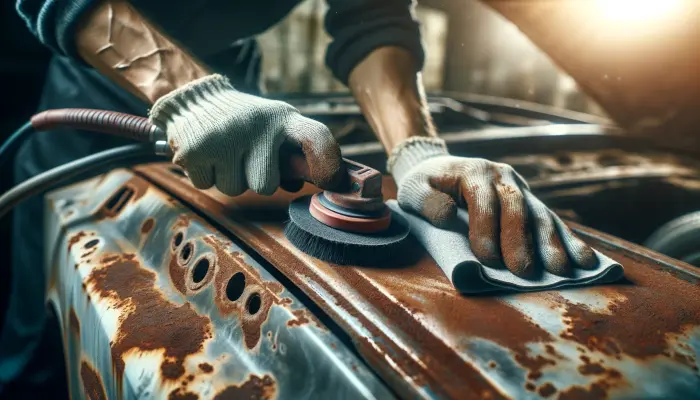Rust on a car body appears due to the exposure of the metal surface to moisture and oxygen. This natural oxidation process accelerates with damage to the paint, salt, dirt, and other aggressive factors. Areas most prone to corrosion are those with peeling paint, scratches, dents, seams, and welds.
Types of Rust
There are two main types of rust: surface and deep. Surface rust is a thin layer of rusty deposit on the paint. Deep rust penetrates the metal by millimeters, destroying it. The most dangerous is through corrosion, completely eating through the part.
Means of Rust Removal
Various means are used to combat rust, which can be divided into three main groups:
Mechanical means involve various tools that physically remove rust from the metal surface. These include: Stiff metal brushes for vigorously scrubbing rusted areas to flake off loose corrosion. Brushes come in cylindrical and dome shapes. Sandpaper with a grit from P80 to P120 for carefully sanding the surface to remove rust. The finer the grit, the smaller the scratches on the metal. Sandblasting machines for deep cleaning of the entire body. Sand, soda, or shot is blasted under pressure onto rusted areas to completely remove all layers of rust. Chemical means are products that remove rust through a chemical reaction. They include: Rust inhibitors, substances that block corrosion processes. They are applied to fresh rust spots to stop further development. Rust converters, compounds that quickly penetrate rust and convert it into strong, stable, dark-colored compounds. Phosphating compounds based on phosphoric acid. They chemically convert rust into a sturdy phosphate film.
Protective materials are necessary after removing corrosion to prevent its recurrence:
Primers with anti-corrosion effects create a protective film on the surface. Enamels and paints restore the paint coating. Protective mastics and waxes fill microcracks, preventing moisture penetration. Paint restorers are used for local repair of damaged areas.
How to Remove Rust from a Car by Yourself?
Rust can be removed from the body using mechanical and chemical methods. It's best to use them in combination:
First, remove flaking rust mechanically with stiff brushes, sanding paper, or sandblasting. This cleans the surface of loose corrosion foci. Then treat areas of deep rust with chemical agents - inhibitors, converters, or phosphating compounds. They penetrate the remaining foci and neutralize corrosion processes. Afterward, thoroughly dry the treated areas, degrease, and apply primer. This prevents rust from reappearing. Apply protective paint coating. Now the body will be reliably protected from corrosion.
This combined approach allows for the most effective rust removal and prevention of its recurrence.
How to Remove Rust from a Car by Yourself?
You can remove rust from a car body using mechanical and chemical methods. It's best to use them in combination:
First, mechanically remove flaking rust using stiff brushes, sandpaper, or sandblasting. This will clear the surface of loose corrosion spots. Then, treat areas of deep rust with chemical agents such as inhibitors, converters, or phosphating compounds. They will penetrate the remaining spots and neutralize the corrosion processes. Afterward, thoroughly dry the treated areas, degrease, and apply a primer. This prevents the rust from reappearing. Apply a protective paint coating. Now the body will be reliably protected from corrosion. This combined approach is maximally effective in removing rust and preventing its recurrence.
How to Remove Rust Mechanically?
Mechanical methods are suitable for removing shallow surface rust. Their advantage is that they physically remove corrosion foci without using chemicals. For mechanical cleaning, use:
Stiff metal brushes to vigorously scrub rusted areas, scraping off loose rust. Brushes with double notches in the bristles are more effective. Sandpaper with a grit of P80-P120 to carefully clean the surface, removing a thin layer of rust. The finer the grain, the fewer scratches will remain. Sandblasting machines to clean the entire body surface of rust. Sand, shot, or soda is blasted under high pressure onto rusted areas.
After mechanical cleaning, be sure to:
Remove all traces of corrosion products if rust reappears. Thoroughly degrease the surface with special compounds to remove all impurities. Properly dry the cleaned areas to eliminate any remaining moisture. Otherwise, rust may reappear even after quality cleaning.
How to Remove Rust Chemically?
Chemical agents allow you to remove even deep rust foci. Their advantages:
Quickly penetrate through metal pores, dissolving rust from the inside. Less labor-intensive than mechanical cleaning. Do not scratch the surface like sanding. Transform rust into inert compounds that protect the metal.
For chemical treatment, use:
Rust inhibitors, substances that passivate corrosion processes. Apply them to fresh rust spots. Rust converters, compounds that change its chemical structure. Converted rust is not harmful to metal. Phosphating compounds that turn rust into a sturdy phosphate film.
After chemical treatment, thorough drying and degreasing are also necessary to secure the result. This method is gentle and effective for removing all types of corrosion.
How to Delay the Corrosion Process?
To slow down the rust formation process on a car body, a comprehensive approach to corrosion protection is required:
Regularly wash the car using special auto shampoos. This helps remove aggressive road pollutants - salt, dirt, which provoke corrosion. Wash no less than once every two weeks. Timely polish the body with polishes containing protective additives. This fills microcracks in the paint coating, enhancing its protective properties. Recommended polishing 1-2 times a year. Update the car's paint coating as chips and scratches appear, which expose the metal. Otherwise, moisture will penetrate through them and activate corrosion. Use anti-corrosion compounds to protect the underbody, wheel arches, thresholds - areas most vulnerable to rust. Apply once a year. Store the car in closed, dry places with an optimal temperature of +5...+15°C. Avoid sharp temperature and humidity fluctuations. Use anti-corrosion agents like ACF-50, Solvol Autosol for preserving the car during long-term storage. Regularly inspect the underbody, thresholds, arches for rust spots for timely treatment.
This comprehensive approach to care and protection will maximize the vehicle's lifespan and delay the onset of rust.
